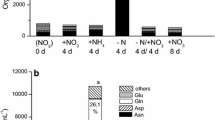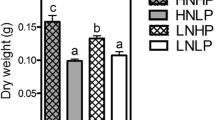Abstract
The uptake of sulphate into roots of barley seedlings is highly sensitive to phenylglyoxal (PhG), an arginine-binding reagent. Uptake was inhibited by >80% by a 1-h pre-treatment of roots with 0.45 mol · m−3 PhG. Inhibition was maximal in pre-treatment solutions buffered between pH 4.5 and 6.5. Phosphate uptake, measured simultaneously by double-labelling uptake solutions with 32P and 35S, was less susceptible to inhibition by PhG, particularly at pH <6.5, and was completely insensitive to the less permeant reagent p-hydroxyphenylglyoxal (OH-PhG) administered at 1 mol · m−3 at pH at 5.0 or 8.2; sulphate uptake was inhibited in -S plants by 90% by OH-PhG-treatment. Root respiration in young root segments was unaffected by OH-PhG pre-treatment for 1 h and inhibited by only 17% after 90 min pre-treatment. The uptake of both ions was inhibited by the dithiol-specific reagent, phenylarsine oxide even after short exposures (0.5–5.0 min). Sulphate uptake was more severely inhibited than that of phosphate, but in both cases inhibition could be substantially reversed by 5 min washing of treated roots by 5 mol · m−3 dithioerythritol. After longer pre-treatment (50 min) with phenylarsine oxide, inhibition of the ion fluxes was not relieved by washing with dithioerythritol. Inhibition of sulphate influx by PhG was completely reversed by washing the roots for 24 h with culture solution lacking the inhibitor. The reversal was dependent on protein synthesis; less than 20% recovery was seen in the presence of 50 mmol · m−3 cycloheximide. Sulphate uptake declined rapidly when -S roots were treated with cycloheximide. In the same roots the phosphate influx was little affected, small significant inhibitions being seen only after 4 h of treatment. Respiration was depressed by only 20% in apical and by 31% in basal root segments by cycloheximide pre-treatment for 2 h. Similar rates of collapse of the sulphate uptake and insensitivity of phosphate uptake were seen when protein synthesis was inhibited by azetidine carboxylic acid, p-fluorophenylalanine and puromycin. Considering the effects of all of the protein-synthesis inhibitors together leads to the conclusion that the sulphate transporter itself, or some essential sub-component of the uptake system, turns over rapidly with a half-time of about 2.5 h. The turnover of the phosphate transporter is evidently much slower. The results are discussed in relation to strategies for identifying the transport proteins and to the regulation of transporter activity during nutrient stress.
Similar content being viewed by others
Abbreviations
- CAP:
-
chloramphenicol
- CHM:
-
cycloheximide
- DTE:
-
dithioerythritol
- OH-PhG:
-
p-hydroxyphenylglyoxal
- PhAsO:
-
phenylarsine
- PhG:
-
phenylglyoxal
References
Bhatti, A.S., Loneragan, J.F. (1970) Phosphorus concentrations in wheat leaves in relation to phosphorus level. Agron. J. 62, 288–290
Breeze, V.G., Hopper, M.J. (1987) The uptake of phosphate by plants from flowing nutrient solution. IV. Effect of phosphate concentration on the growth of Trifolium repens L. supplied with nitrate, or dependent upon symbiotically fixed nitrogen. J. Exp. Bot. 38, 618–630
Breeze, V.G., Wild, A., Hopper, M.J., Jones, L.H.P. (1984) The uptake of phosphate by plants from flowing nutrient solution. II. Growth of Lolium perenne L. at constant phosphate concentrations. J. Exp. Bot. 35, 1210–1221
Brunold, C., Schmidt, A. (1978) Regulation of sulfate assimilation in plants. 7. Cysteine inactivation of adenosine S'-phosphosulfate sulfotransferase in Lemna minor L. Plant Physiol. 61, 342–347
Brunold, C., Suter, M., Lavanchy, P. (1987) Effect of high and low sulfate concentration on adenosine 5′-phosphosulfate sulfotransferase activity from Lemna minor. Plant Physiol. 70, 168–174
Cacco, G., Saccomani, M., Ferrari, G. (1977) Development of sulphate uptake capacity and ATP-sulphurylase activity during root elongation in maize. Planta 60, 582–584
Clarkson, D.T., Saker, L.R. (1989) Sulphate influx in wheat and barley becomes more sensitive to specific protein-modification reagents when plants are sulphate-deficient. Planta 178, 249–257
Clarkson, D.T., Scattergood, C.B. (1982) Growth and phosphate transport in barley and tomato plants during the development of, and recovery from phosphate-stress. J. Exp. Bot. 33, 865–875
Clarkson, D.T., Hawkesford, M., Saker, L. (1989a) The sulphate transporter in roots: physiological behaviour and attempted identification. In: Plant Membrane transport: The current position, 401–402, Dainty, J., de Michaelis, M.I., Marrè, E. and Rasi-Caldogno, F. eds. pp. Elsevier, Amsterdam
Clarkson, D.T., Saker, L.R., Purves, J.V. (1989b) Depression of nitrate and ammonium influx in barley plants with diminished sulphate-status. Evidence for co-regulation in nitrogen and sulphate intake. J. Exp. Bot. 40, 953–963
Clarkson, D.T., Smith, F.W., Vanden Berg, P.J. (1983) Regulation of sulphate transport in a tropical legume, Macroptilium atropurpureum, cv. siratro. J. Exp. Bot. 34, 1463–1483
Cogliatti, D.H., Clarkson, D.T. (1983) Physiological changes in potato plants during development of, and recovery from phosphate stress. Physiol. Plant. 58, 287–294
Cooke, D.T., Burden, R.S., Clarkson, D.T., James, C.S. (1989) Xenobiotic induced changes in membrane lipid composition: effects on plasma-membrane ATPases. In: Mechanisms and regulation of transport processes (Monogr. 18,) pp. 41–53, Atkin, R.K., Clifford, R.D. eds. British Plant Growth Regulator Group, Wantage, UK
Cram, W.J. (1990) Uptake and transport of sulfate. In: Sulfur nutrition and sulfur assimilation in higher plants, pp. 3–11, Rennenberg, H., Brunold, C., De Kok, L., Stulen, I., eds. SPB Academic Publishing, The Hague
Delieu, T., Walker, D.A. (1972) An improved cathode for the measurement of photosynthetic oxygen evolution by isolated chloroplasts. New Phytol. 71, 201–205
Dhugga, K.S., Waines, J.G., Leonard, R.T. (1988) Nitrate absorption by corn roots. Inhibition by phenylglyoxal. Plant Physiol. 86, 759–763
Doddema, H., Otten, H. (1979) Uptake of nitrate by mutants of Arabidopsis thaliana, disturbed in uptake or reduction of nitrate. III. Regulation. Physiol. Plant. 45, 339–346
Doddema, H., Hofstra, J.J., Feenstra, W.J. (1978) Uptake of nitrate by mutants of Arabidopsis thaliana, disturbed in uptake or reduction of nitrate. I. Effect of nitrogen source during growth, on uptake of nitrate and chlorate. Physiol. Plant. 43, 343–350
Drew, M.C., Saker L.R. (1984) Uptake and long distance transport of phosphate, potassium and chloride in relation to internal ion concentrations in barley: evidence of non-allosteric regulation. Planta 160, 500–507
Ferrari, G., Renosto, F. (1972) Comparative studies of the active transport by excised roots of inbred and hybrid maizeJ. Agric. Sci. 79, 105–108
Gildensoph, L.H., Briskin, D.P. (1989) Modification of an essential arginine residue associated with the plasma membrane ATPase of red beet (Beta vulgaris L.) storage tissue. Arch. Biochem. Biophys. 271, 254–259
Green, D.G, Ferguson, W.S., Warder, F.G. (1973) Accumulation of toxic levels of phosphorus in the leaves of phosphorus-deficient barley. Can. J. Plant Sci. 53, 241–246
Hawkesford, M.J., Belcher, A.R. (1991) Differential protein synthesis in response to sulphate and phosphate deprivation: Identification of possible components of plasma-membrane transport systems in cultured tomato roots. Planta 185, 323–329
Hewitt, E.J. (1952) Sand and water culture methods used in the study of plant nutrition. pp. 241. Commonwealth Agricultural Bureaux, Farnham Royal
Jensen, P., König, T. (1982) Development of regulation mechanisms for SO4 2--influx in spring wheat. Physiol. Plant. 55, 459–64
Larsson, C., Widell, S., Kjellbom, P. (1987) Preparation of highpurity plasma membranes. Methods Enzymol. 148, 558–568
Lee, R.B., Ratcliffe, G.R. (1990) 31P NMR Measurements of the cytoplasmic and vacuolar Pi content of mature maize roots: relationships with phosphorus status and phosphate fluxes. J. Exp. Bot. 41, 1063–1078
Lefebvre, D.D., Glass, A.D.M. (1982) Regulation of phosphate influx in barley roots: effects of phosphate deprivation and reduction of influx with provision of orthophosphate. Physiol. Plant. 54, 199–206
McClure, P.R., Kochian, L.V., Spanswick, R.N., Schaff, J. (1990a) Evidence for cotransport of nitrate and protons in maize roots. I. Effects of nitrate on the membrane potential. Plant Physiol. 93, 281–289
McClure, P.R., Kochian, L.V., Spanswick, R.N., Schaff, J. (1990b) Evidence for cotransport of nitrate and protons in maize roots. II. Measurements of NO3 - and H+ fluxes with ion-selective microelectrodes. Plant Physiol. 93, 290–194
Ni, M., Beevers, L. (1990a) Influence of arginine-specific reagents on nitrate uptake by corn seedlings. J. Exp. Bot. 41, 987–993
Ni, M., Beevers, L. (1990b) Essential arginine residues in the nitrate system from corn seedling roots. Plant Physiol. 94, 745–751
Rennenberg, H., Kemper, D., Thoene, B. (1989) Recovery of sulphate transport into heterotrophic tobacco cells from inhibition by reduced glutathione. Physiol. Plant. 76, 271–276
Renosto, F., Ferrari, G. (1975) Mechanism of sulfate transport inhibition by cycloheximide in plant tissues. Plant Physiol. 56, 478–480
Sauer, N. (1986) Hexose-transport-deficient mutants of Chlorella vulgaris. Lack of transport activity correlates with absence of inducible proteins. Planta 168, 139–144
Sauer, N., Tanner, W. (1989) The hexose carrier from Chlorella-cDNA cloning of a eukaryotic H+-cotransporter. FEBS Lett. 259, 43–46
Schmidt, A. (1986). Regulation of sulfur metabolism in plants. Progr. Bot. 48, 133–150
Smith, I.K. (1975) Sulfate transport in cultured tobacco cells. Plant Physiol. 55, 303–307
Stipani, I., Zara, V., Zaki, L., Prezioso, G., Palmieri, F. (1986) Inhibition of the mitochondrial tricarboxylate carrier by arginine-specific reagents. FEBS Lett. 205, 282–286
Takahashi, K. (1968) The reaction of phenylglyoxal with arginine residues of proteins. J. Biol. Chem. 243, 6171–6179
Thibaud, J-B. Davidian, J-C. Sentenac, H. Soler, A., Grignon, C. (1988) H+ co-transports in corn roots related to surface pH shift induced by active H+ excretion. Plant Physiol. 88, 1469–1473
Author information
Authors and Affiliations
Additional information
Paper dedicated to the memory of the late Ken Treharne who did much to encourage this collaboration.
D.T.C. gratefully acknowledges a fellowship provided by Le Ministére des Etrangers during his stay in Montpellier.
Rights and permissions
About this article
Cite this article
Clarkson, D.T., Hawkesford, M.J., Davidian, JC. et al. Contrasting responses of sulphate and phosphate transport in barley (Hordeum vulgare L.) roots to protein-modifying reagents and inhibition of protein synthesis. Planta 187, 306–314 (1992). https://doi.org/10.1007/BF00195653
Received:
Accepted:
Issue Date:
DOI: https://doi.org/10.1007/BF00195653




